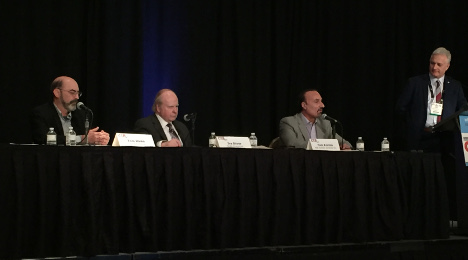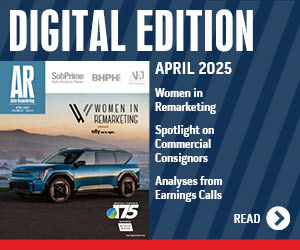3 economists dissect current CPO market condition

Economist panel at the CAR Conference in Las Vegas. Photo by Joe Overby.
As one wholesale market economist called the certified pre-owned market one of the “good guys,” another economist specializing in the wholesale space offered a recommendation to make the CPO segment even better, especially for franchised dealerships.
KAR Auction Services chief economist Tom Kontos, NAAA chief economist Ira Silver and Cox Automotive chief economist Tom Webb participated in a panel discussion at the recent Conference of Automotive Remarketing in Las Vegas where the dialogue eventually turned to the CPO market, which generated retail sales of 211,475 units in February, according to Autodata Corp.
Autodata also pegged year-to-date sales of certified units at 404,076 as eight automakers that often generate some of the largest CPO volume are off to strong starts again in 2017.
“It’s been one of the real good guys for all of us here in the remarketing industry that we’ve had such an acceptance and growth in CPO sales,” Kontos said in light of February’s figure representing a 9.8-percent rise on a sequential basis. “It’s really been a demand side supporter for residual and resale values of used vehicle.
“Things will tend to plateau,” he continued. “It’s now just under 20 percent of franchised dealer used-vehicle sales are CPO sales. There’s probably an upward limit to how much more that can grow. But I do expect modest growth in 2017 in CPO sales and that will continue to support used-vehicle values.”
The year-to-date figure bolstered Kontos’ point as the total represented just a 0.4-percent lift compared to the first two months of last year.
In his commentary associated with the release of the February Manheim Used Vehicle Value Index, Webb explained how the fact that CPO car sales softened by 5 percent in February while CPO truck sales climbed 5 percent supports the theory that CPO sales growth is possibly being restrained by small potential gross profit lifts in certain segments.
Webb went on to point out the theory is further supported by the 10-percent decline in domestic brand CPO sales, a 1-percent increase for mid-line imports and a 15-percent increase for luxury units.
During the CAR Conference, Webb said, “I think that supports my theory that one of the reasons why a dealer decides not to certify a unit is because margins are so skinny. They don’t see a lot of potential lift.
“It supports that theory that you’ve got to have some gross,” he went on to say. “It’s not like these cars weren’t sold as used. It’s the dealer who makes the decision whether it’s a CPO or not. They decided not to certify because the margin were so skinny. Dare I make a recommendation to those involved in your OEM’s CPO program, you have to remember that you have to leave a profit for the dealer.”
Interest rate impact
With the likelihood those CPO turns are likely to be financed by the buyer, Kontos, along with Silver, briefly touched on any actions taken by the Federal Reserve involving interest rates might do to activities in the F&I office.
“The prospect is very likely that interest rates will move up,” Silver said. “That’s a negative for subprime, but it doesn’t look like the increase will be too drastic. I think the Fed wants to turn this (low-rate accommodation) off but not fight too much against growth.”
When the Fed has modified interest rates, it’s been by 0.25 percent. Chair Janet Yellen signaled a similar move could be made when the Federal Open Market Committee (FOMC) meets next week.
“The amount of increase is likely to be manageable for the auto lending space in that the auto lending space has traditionally been very competitive in their ways to manage their cost of funds. I don’t see the significant impact in the ability for the consumer to be able to borrow,” Kontos said.
Senior editor Joe Overby contributed to this report.


